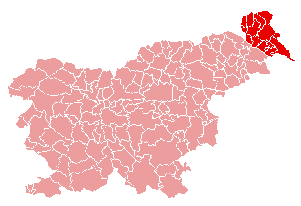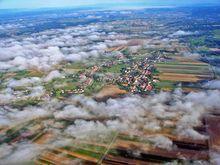Prekmurje

Prekmurje (Hungarian: Muravidék, Prekmurje dialect: Prèkmürsko,[1] or Prèkmüre) is the easternmost region of Slovenia. It borders Hungary to the north-east, Austria to the north-west, Croatia to the south and the Slovenian region of Styria to the south-west. For about a thousand years, it was part of the Kingdom of Hungary, unlike other Slovene Lands. It therefore maintains certain specific linguistic, cultural and religious features that differentiate it from other Slovenian historical regions.
Contents |
Name
It is named after the Mura River, which separates it from the rest of Slovenia (a literal translation from Slovene would be Over-Mura or Transmurania). In Hungarian, the region is known as Muravidék, and in German as Übermurgebiet.
The name Prekmurje has been introduced relatively recently. Before 1919, the Slovenian-inhabited lands of the Vas County in the Kingdom of Hungary were known under the name Slovene March or "Vendic March" (in Slovenian: Slovenska krajina, in Hungarian: Vendvidék). The part of modern Prekmurje that belonged to the Zala County (the area between Lendava, Kobilje and Beltinci) was not considered to be part of the Slovenian March. However, until the early 19th century, this region of the Zala county belonged ecclesiastically to the Archdiocese of Zagreb and in the legal documents of the Archdiocese it was called as "Transmurania" or "Prekmurje", that is the "territory on the other side of the Mura river". After 1919, this name was rediscovered and introduced again, now for administrative purposes, by the new Yugoslav administration. It however did not gain much popularity among the locals: the name "Slovenian March" was still used by the local inhabitants till mid 1920s, but was later replaced by the term "March of the Mura" (Slovenian: Murska krajina), which became the most used name for the region till World War II. The current Hungarian name for Prekmurje, Muravidék, still dates from that period and is a translation of the Slovenian Murska krajina. It was only after World War II that the name Prekmurje became predominant and quickly replaced all previous denominations.
Nowadays, the old term Vendvidék still exists in Hungarian, but is used only for the small settlement area of Hungarian Slovenes between Szentgotthard and the Slovenian border, that has remained in Hungary after 1919.

Geography

The region is divided into three geographical subregions: hilly area to the north of Murska Sobota, known as the Goričko; the eastern flatlands strching between the Mura River, known as Ravensko (literary, "The Flatlands"), and the western lowlands around Lendava, known as Dolinsko (literary, "The Lowlands").
The administrative and commercial centre of the region is the town of Murska Sobota. The only other bigger town is Lendava. Other larger rural centres are Dobrovnik, Turnišče, Beltinci, and Črenšovci.
Population

The majority of the inhabitants of the region are ethnic Slovenes. There is also a sizable Hungarian minority in the region, as well as a large number of Roma.
In 1921, the total population of the area numbered 92,295 people, including 74,199 speakers of the Slovenian, 14,065 speakers of Hungarian, and 2,540 speakers of German. Since then, the number of Hungarian speakers has been falling slowly but steadily. The German-speaking community, which used to be concentrated in three villages near the Austrian border and in Murska Sobota, was either assimilated or expelled after World War Two.
Since the early 1950s, Hungarian has had co-official status in the areas of traditional settlement of the Hungarian minority. Three municipalities (Lendava, Hodoš and Dobrovnik) are completely bilingual, while two (Šalovci and Moravske Toplice) are only partially. Two municipalities, Hodoš and Dobrovnik, have a Hungarian majority.
Prekmurje has traditionally been the most heterogeneous Slovene region regarding religious affiliation. Besides a Roman Catholic majority, there is a significant Protestant (mostly Lutheran) minority, concentrated in the Goričko hills, which represents between one fourth and one fifth of the population of Prekmurje. Before World War Two, there used to be a significant Jewish community, as well, mostly concentrated in the towns of Murska Sobota and Lendava (Lendava Synagogue). In the 1930s, two thirds of all Slovenian Jews lived in Prekmurje. Most of them perished in the holocaust. There is also a significant presence of Roma people in the region, making Prekmurje one of the two major settlement areas of Slovenian Romas (the other being Lower Carniola).
History
- see also Slovene March (Kingdom of Hungary), Republic of Prekmurje

The region has had a turbulent history: it has been inhabited since the Stone Age, it was later included the Roman Empire and subsequently in the Kingdom of the Ostrogoths, the Kingdom of the Lombards, the Kingdom of the Avars, the Frankish Empire, the Balaton Principality (9th century), Arnulf's Kingdom of Carantania (10th century). In the late 10th century it was invaded by the Magyars and it remained part of the Kingdom of Hungary until 1919, when it was annexed to the Kingdom of Serbs, Croats and Slovenes.
During the Roman rule, the region was part of the province of Pannonia. Although, some earlier Slavic settlements had probably existed in the area, the ancestors of modern Slovenes moved from eastern Alps and settled in Prekmurje after Franks defeated the Avars during the reign of Charlemagne. In the 9th century, this area was part of the Slavic state known as the Balaton Principality. The center of this state was in the city of Blatnograd near the Balaton lake. The principality was later dissolved and integrated in the Kingdom of Carantania established by the German Emperor Arnulf of Carinthia. This political entity in which all the ancestors of modern Slovenes were united under one ruler was soon destroyed by the Magyar invaders who conquered the Pannonian plain and was incorporated it into the Kingdom of Hungary. The area inhabited by Slovenes shrank to the present extent by the end of the 12th century and has remained stable since. The region was part of the Vas County between 11th century and 1526.
In 1526, like the rest of western Hungary, Prekmurje came under Habsburg rule, although some villages had to pay the tribute to the Ottoman administration during short periods between 1566-1688. For a short period, Beltinci, under the name "Balatin", became the sanjak center of the Ottoman Kanizsa Province. In 1687, the Vas County was restored: with the small interruption from 1849 to 1867, most of Prekmurje belonged to this county except for Lendava district, which was part of Zala county until 1918.
After the end of World War One, following a short-lived Republic of Prekmurje that emerged in midst of the chaos of the Hungarian Revolution of 1919, the region was occupied by Yugoslav troops and incorporated in the newly established Kingdom of Serbs, Croats and Slovenes (renamed to Yugoslavia in 1929). In 1918 the catholic politicians and József Klekl was like to design a autonomous entity or independent state, with the name Slovenska krajina. Between 1918 and 1922, the region belonged to the Maribor county, and between 1929 and 1941 to the Drava Banovina with the capital Ljubljana. During World War II, it was occupied and annexed by Horthy's Hungary from 1941 to 1944 and by Nazi Germany between 1944 and 1945. It was liberated by Soviet troops in May 1945. After the war it became part of the Socialist Republic of Slovenia, which was one of the newly formed republics of Yugoslavia.
The languages of Prekmurje
The majority of the population of Prekmurje uses Slovene, either in its standard form or in its regional variant, the Prekmurje dialect and significant part of them speaks Hungarian or Romani.
As the county was for long time part of the Hungarian Crown, the Hungarian language was traditionally used here. After the storms of the two World Wars when the land was not anymore Hungarian ruled, the Hungarian language use was decreased dramatically as a consequence of the assimilation during the Yugoslavian governance.
However, in the border areas, especially around Lendava, Hungarian is also used. In the officially bilingual areas, Hungarian is recognized by the Slovenia governance and is used as the second official language next to Slovene. All public signs are written in both languages, and the primary and secondary education is bilingual.
The Prekmurje dialect long served as the regional language of the Prekmurje region and the Slovenes in Hungary. It had a codified standard language, and even a tiny own literary corpus of around 2-300 works. However, after the 1930s, and especially after the end of World War Two, the use of the written Prekmurje dialect declined drastically, and almost disappeared. Nevertheless, it has continued to be used by wide strata of the population, and the region has retained its own specificities against the linguistic infiltrations from standard Slovene. Most of the Slovene speakers in the region thus live in a situation of diglossy. While the minor languages-dialects are still widely used in most spheres of private life, especially in the rural areas, standard Slovene is used in education, media and public life.
Some of the Roma population in the region have retained Romani. The Slovenia recognizes Romani as a minority language, but this official recognition has very little factual consequences. The legal protection of Romani is incomparably weaker than of Hungarian.
Cuisine
The region is known for its distinctive cuisine. Among traditional dishes, the best known are a pork, turnip and millet casserole called bujta repa and a layered pastry called prekmurska gibanica.
Notable people
see also List of Slovene writers and poets in Hungary
- Mihael Bakoš, Lutheran preacher and author;
- Fabian Cipot, football player;
- Rudi Čačinovič, diplomat;
- Zdenka Čebašek Travnik, Slovenian ombudsmann;
- Evald Flisar, writer;
- László Göncz, historian and politician;
- Andrej Horvat, economist and politician;
- Feri Horvat, politician, Chairman of the Slovenian National Assembly (2004);
- Ferenc Ivanóczy, writer and politician
- Miško Kranjec, writer;
- Vlado Kreslin, singer;
- Milan Kučan, politician, President of Slovenia (1990-2002);
- Štefan Küzmič, Lutheran preacher and author;
- Mikloš Küzmič, writer and translator;
- Feri Lainšček, writer;
- Oto Luthar, historian;
- Miki Muster, cartoonist;
- Vilko Novak, ethnologhist, writer, poet, teacher, linguist
- Avgust Pavel, ethnologist and translator;
- Mária Pozsonec, politician;
- Dušan Šarotar, writer;
- Cvetka Tóth, philosopher;
- Ludvik Vrečič, painter;
- Radovan Žerjav, politician.
See also
- Prekmurje dialect
- Prekmurje Slovenes
- Slovene March (Kingdom of Hungary)
- Republic of Prekmurje
- Wendish question
- Međimurje
References
- ↑ Források a Muravidék történetéhez/Viri za zgodovino Prekmurja, 292. p.
External links
|
||||||||||